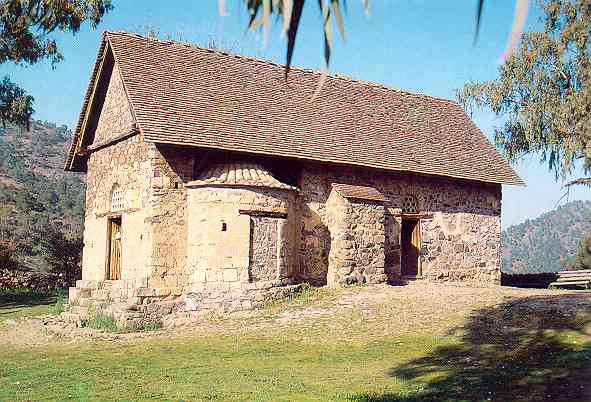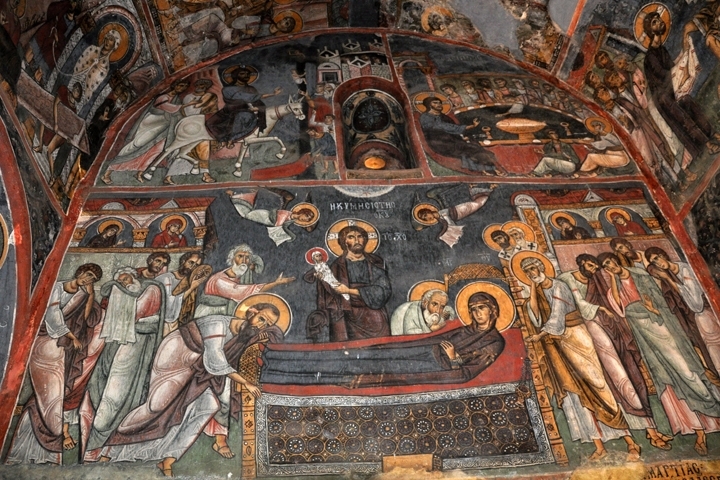Conference excursion
SOCIAL EXCURSION TO THE ASINOU CHURCH (11 th CENTURY)
UNESCO WORLD HERITAGE MONUMENT
Date: Wednesday 2nd November 2016, 09.30 a.m. - 18.30 p.m.
Meeting place: Filoxenia

A full day excursion to the Asinou UNESCO WHL monument will be organized exclusively for the EuroMed2016 participants. Luxury fully insured air-conditioned buses will transfer the participants to the church, which is located 45km away from the Cypriot capital, Nicosia. There, the participants will be provided a tour about the history and the evolution of the church through time. The tour will be carried out by the fellows who are actively involved in the Marie Curie Initial Training Network for Digital Cultural Heritage (ITN-DCH www.itn-dch.eu) and have studied the Asinou monument as part of their research training. This presentation is considered to be part of the dissemination and outreach of their research results.

The church of Panagia Phorviotissa, or Panagia Asinou (Panagia is called in Greek the Mother of God), named after the nearest village that used to exist in the area, is located on the north foothills of one of the mountains that dominate Cyprus’s inland center, Troodos mountain, on the east bank of a stream, three kilometers south of Nikitari village. According to the dedicatory inscription above its south entrance the church was initially erected between 1099 and 1105 CE by the magistrate Nikiphoros
Ischyrios (donator) who, after his wife’s death took a monastic vow and became a monk under the name
Nikolaos. The church used to be the katholicon (monastery church) of the Monastery of Phorvion, which
ceased its function in 1825 CE; the church is the only remain of the monastic building complex that has
reached our times.
Architecture: The church consists of two parts: the vaulted single-aisled nave and the narthex, the latter one
being a later addition belonging to the second half of the 12 th century. The narthex with its two semi-circular
apses and calotte belongs to a type directly influenced by Constantinople. Already from the 12 th century a
steep-pitched timber roof, covered with flat tiles, sheltered the church. The church has suffered great
damages especially from earthquakes. Towards the end of the 13 th century or at the beginning of the 14 th
century the conch of the apse collapsed and was soon after rebuilt and redecorated. At the same time the
external buttresses were added and a little later, the flying buttress at the eastern end of the north wall was
built.
Wall paintings: The church of Asinou has a vivid colorful interior, due to the frescoes depicting various
scenes from the Orthodox Christian faith and is among the most cherished sites in Cyprus. It was painted
immediately after the construction of the nave had been finished in 1105/6 CE expressing the latest style of
the Comnenian period. These are the earliest original and most important mural paintings of the church,
many of which are preserved in the apse of the Holy Bema (sanctuary) and the east and west wall of the
church (initial layer of paintings), such as The Dormition of Virgin Mary, the Assumption and the Communion
of the Apostles and Panagia Phorviotissa on the arch over the initial entrance to the church. They distinguish
for their color, rhythm and harmony, the restrained expression and mobility of movement. Experts believe
that they are of the few surviving frescoes that reflect the technique of Constantinople, thought to be the
birthplace of the artist. The strong influence of the Empire’s capital can be explained by the fact that the
prevailing geopolitical conditions of the time led Alexios Comnenos (1081-1118 CE) to render Cyprus his
most important military base of the north-eastern Mediterranean.
The narthex was also decorated with mural paintings soon after its erection during the second half of the
12 th century, while it was redecorated in 1332/3 CE following strong Frankish influences. In this layer of
iconographic programme of the 14 th century a large number of donors can be distinguished, while under it
only parts of the original beautification of the narthex (12 th century) have survived and can be detected
nowadays. Moreover, a mounted St. George painted in the 13 th century on the narthex’s south arch as a
votive wall painting of a certain Nikiphoros Kallia, is most interesting and is part of a “portrait gallery” of the
numerous donors. Also interesting is the wall painting of the Virgin Mary with Frankish donors on the semi-
dome of the southern arch of the narthex, in which the female donor wears a long black veil, common
amongst refugees from Syria to Cyprus mourning the fall of Acre in 1291.
Several wall paintings dating from the 17 th century also survive in the church, including Christ Emmanuel
(located in the sanctuary). All the aforementioned wall paintings of different periods in the church are the
result of the various redecorations that have taken place throughout the lifetime of the monument and are
considered to be some of the most important remains of the Byzantine painting.
Since 1985 the Asinou church is declared as an UNESCO World Heritage Site and belongs to the Troodos
Painted Churches group. These are the painted churches which up to this day have preserved brilliant
examples of various trends of Byzantine and post-Byzantine monumental art, from the 11 th to the 19 th century.
(Virtual Representation of Monument) . In particular, the Asinou church is visited by thirty thousand tourists
per year, while many Cypriots still use the church in order to baptize their children. Accessibility through
well-graded roads, picturesque setting in the foothills of the Troodos mountain and of course, the colorful
interior of the monument make the Asinou church one of the top sightseeing of Cyprus.
The participants visiting Asinou will get the chance to be provided a tour which exceeds the typical
“touristic” presentation of the tourist guides. Being scientists and prominent experts themselves, they will be
provided with a scientific presentation of the state-of-the-art research activities that have been carried out
by the ITN-DCH Marie Sklodowska-Curie fellows, thus acting as a real-life example of the implementation of
multi-scientific and transdisciplinary approach to monument documentation and valorization of the acquired
knowledge. Image-based modelling, 3D data acquisition techniques, digitizing methods and dissemination of
the acquired knowledge are only some of the topics to be demonstrated based on a single case study: that of
Asinou church.







